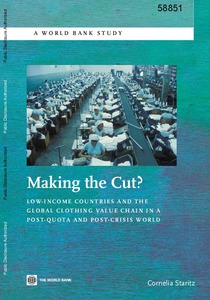Making the cut? low-income countries and the global clothing value chain in a post-quota and post-crisis world
"The clothing sector has traditionally been a gateway to export diversification and industrial development for low-income countries (LICs) but recent developments may condition this role. In most developed and middle-income countries, the clothing sector was central in the industrialization pro...
| Main Author: | |
|---|---|
| Institution: | ETUI-European Trade Union Institute |
| Format: | TEXT |
| Language: | English |
| Published: |
Washington, DC
2011
World Bank |
| Subjects: | |
| Online Access: | https://www.labourline.org/KENTIKA-19112256124919304389-Making-the-cut?-low-income-cou.htm |
| _version_ | 1771659898402111490 |
|---|---|
| author | Staritz, Cornelia |
| author_facet | Staritz, Cornelia |
| collection | Library items |
| description | "The clothing sector has traditionally been a gateway to export diversification and industrial development for low-income countries (LICs) but recent developments may condition this role. In most developed and middle-income countries, the clothing sector was central in the industrialization process. Recently, however, the environment for global clothing trade has changed significantly, driven by the rise of organizational buyers and their global sourcing strategies, the phase-out of the Multi-Fibre Arrangement (MFA) at the end of 2004, and the global economic crisis in 2008-09. Changes in global supply and demand structures have increased competition between LIC exporters but also offer new opportunities in fast-growing emerging markets. The second half of the twentieth century was characterized by a rising demand for clothing and the replacement of developed countries' domestic production by imports from developing countries. Today, however, demand has stagnated and import penetration levels are close to 100 percent in most developed countries. Thus, the growth of clothing exports from a few developing countries largely comes at the expense of clothing producers in other developing countries. The heightened competition between developing countries has been reinforced by overcapacity in the global clothing industry since the MFA phase-out and has been accelerated by the global economic crisis. However, changes in demand structures post-crisis may lead to new opportunities. While import demand for clothing in the Unites States, the European Union (EU), and Japan might stagnate, demand will increase in fast-growing emerging markets." |
| format | TEXT |
| geographic | developing countries |
| id | 19112256124919304389_b4ce89665bd6453d93e569825b598274 |
| institution | ETUI-European Trade Union Institute |
| is_hierarchy_id | 19112256124919304389_b4ce89665bd6453d93e569825b598274 |
| is_hierarchy_title | Making the cut? low-income countries and the global clothing value chain in a post-quota and post-crisis world |
| language | English |
| physical | 177 p. Digital |
| publishDate | 2011 |
| publisher | Washington, DC World Bank |
| spellingShingle | Staritz, Cornelia case study clothing industry economic recession export trade value chains Making the cut? low-income countries and the global clothing value chain in a post-quota and post-crisis world |
| thumbnail | https://www.labourline.org/Image_prev.jpg?Archive=108027992620 |
| title | Making the cut? low-income countries and the global clothing value chain in a post-quota and post-crisis world |
| topic | case study clothing industry economic recession export trade value chains |
| url | https://www.labourline.org/KENTIKA-19112256124919304389-Making-the-cut?-low-income-cou.htm |

